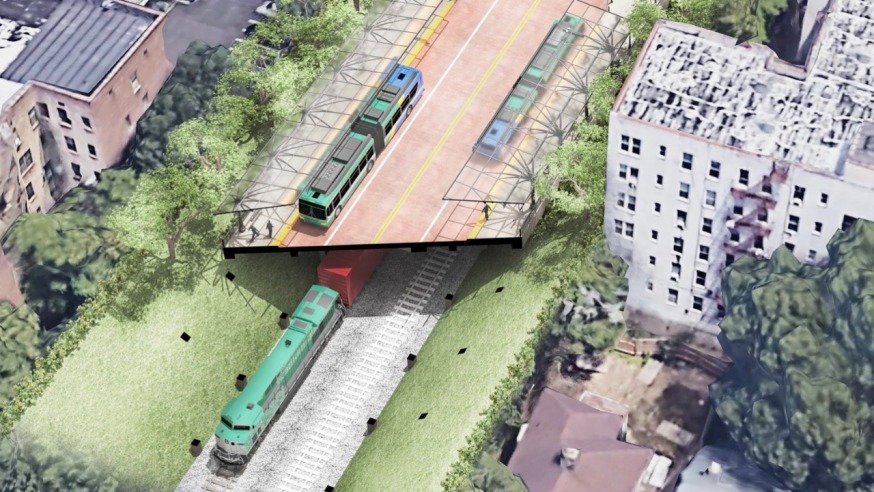
The MTA Interborough Express would consist of either a bus rapid transit system, light rail or conventional heavy rail (Rendering provided by the MTA)
Jan. 21, 2022 By Michael Dorgan
The state’s plan to connect Queens and Brooklyn via a mass transit line has taken a major step forward with the release of a new feasibility study.
The study, announced by Gov. Kathy Hochul and the MTA Thursday, assessed the possibility of converting an existing 14-mile freight line — running from Jackson Heights to Sunset Park — into a commuter railway or bus line.
The yearlong study deemed the project feasible and in high demand. It was commissioned in 2020 and carried out by MTA consultants.
The project would be called the “Interborough Express” or the “IBX,” and its end-to-end travel time would be less than 40 minutes, according to the study. It would offer connections to 17 existing subway lines as well as the Long Island Rail Road and serve up to 88,000 people daily.
Hochul called the project a “once in a generational opportunity,” noting that around half of the 900,000 residents it would serve do not have cars. Around one-third of residents along the corridor are below the 150 percent Federal Poverty Line level while 25 percent of residents speak English “less than well,” according to the study.
“Those are the people we’re trying to serve, those are the people that need that kind of connection and to be lifted out of their everyday existence trying to catch a bus to get to their jobs,” Hochul said at a press conference in Bay Ridge.
She also touted the project as spurring economic growth by creating more than 20,000 union-paying jobs. The study also found that 260,000 jobs exist in the area that would be immediately served by the Interborough Express
The project aims to provide a transit option between the two outer boroughs as an alternative to the Manhattan-centric subway lines. Currently, many New Yorkers who commute between the two boroughs have to take the subway through Manhattan to get to their final destination.
The feasibility study found that more people commute throughout Brooklyn and Queens than commute from those boroughs into Manhattan.
Queens Borough President Donovan Richards said that the Interborough Express would connect families in Queens and Brooklyn to new employment opportunities while dramatically cutting commute times in the process.
“That is a true game-changer for thousands of people on either side of the Queens or Brooklyn border,” Richards said.
He said that the vitality of Queens and Brooklyn depends heavily on the reliability of its public transportation system.
“But for far too many families in both boroughs… the inability to travel between Queens and Brooklyn in a quick, efficient manner has been an unnecessary detriment to their economic well-being.”
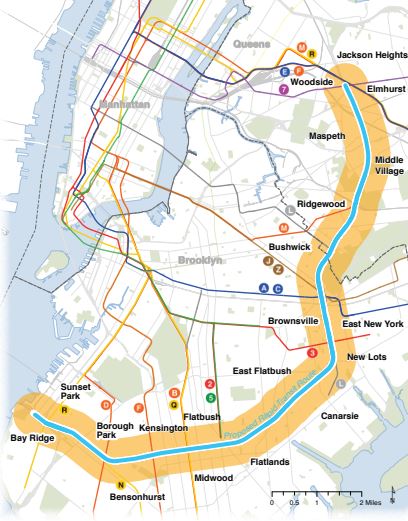
The service would connect the Queens neighborhoods of Jackson Heights, Elmhurst, Maspeth, Middle Village and Ridgewood (Map provided by the MTA via the Interborough Express feasibility study)
The Interborough Express would utilize a portion of the Bay Ridge Branch freight rail that runs north-south through Queens and Brooklyn.
The service would connect the Queens neighborhoods of Jackson Heights, Elmhurst, Maspeth, Middle Village and Ridgewood and the Brooklyn neighborhoods of Bushwick, East New York, Brownsville, New Lots, Flatlands, Flatbush, Midwood, Kensington, Borough Park and Sunset Park.
Many of these communities have no rail transit. The Interborough Express would change that by adding stops in these areas.
According to the study, the potential mode of transport along the line would be either a bus rapid transit system, light rail or conventional heavy rail.
The next step in the process is for the MTA to conduct an environmental review which will include soliciting feedback from the public, elected officials and other stakeholders. The review would determine the most appropriate mode of transit to use and has been given the green light to proceed by Hochul.
A bus rapid transit system would run either alongside the existing freight tracks or above the tracks on a viaduct. The buses would be electrically powered.
The light rail alternative would consist of a two-track line. Most of the line would run side-by-side with the freight tracks while other parts would run on a viaduct above the freight tracks at street level.
The conventional rail option would see two dedicated passenger rail tracks running largely alongside the existing freight rail line. The line would use trains similar to subway cars, allowing for faster boarding and disembarking as well as more standing room on trains.
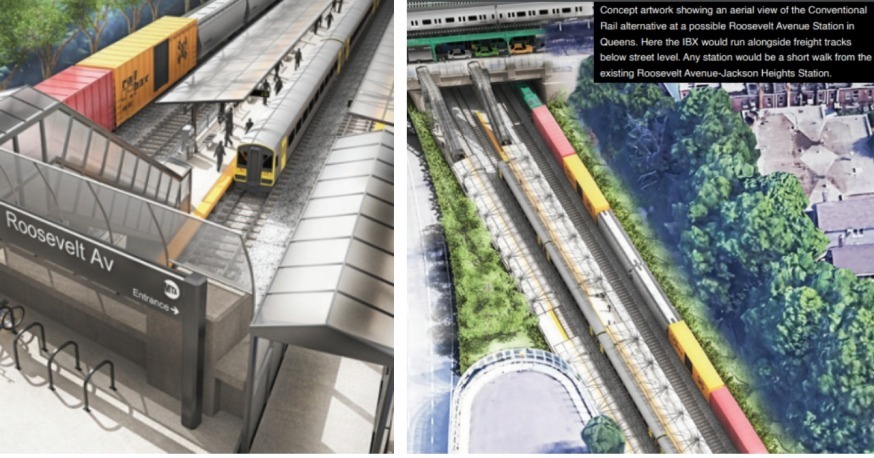
Concepts showing the conventional rail option at a possible Roosevelt Avenue Station (L) and how it would look alongside current freight tracks (Rendering provided by the MTA)
Janno Lieber, MTA Acting Chair and CEO, did not provide a price tag for the project only saying it would be in the “single-digit billions.”
It is also unclear how the project would be financed or what the construction timeline would be. When construction begins, it would likely take “three to five years,” Lieber said.
The release of the study was welcomed by Queens Council Member Robert Holden, who represents District 30 covering Glendale, Maspeth, Middle Village, Ridgewood, Woodhaven and Woodside.
“We have a public transit desert in my district and this project could help a lot of people get around and reduce commute times,” Holden said.
“We need a thorough study to investigate every aspect of how this project would affect every aspect of our neighborhoods.”
The study was also widely welcomed by public transportation advocates.
“The Interborough Express is a big, bold step toward transit equity for millions of riders in Brooklyn and Queens,” said Mayra Aldás-Deckert, lead organizer for Riders Alliance.
“By leveraging old infrastructure and offering new options to people in dozens of dense city neighborhoods, the Interborough Express will greatly enhance access to work, education, healthcare and other essential opportunities.”
The state’s project is similar to a proposal drafted by the NY, NJ and CT-focused transit advocacy group Regional Plan Association in the 1990s. The proposal called “The Triboro” suggests creating a commuter rail on the same existing tracks through Queens and Brooklyn but extending it into Astoria and the Bronx.
The study, however, found that there is not enough space along the existing Hell Gate Line – which connects Astoria to the Bronx — to construct additional tracks as part of the Interborough Express line.
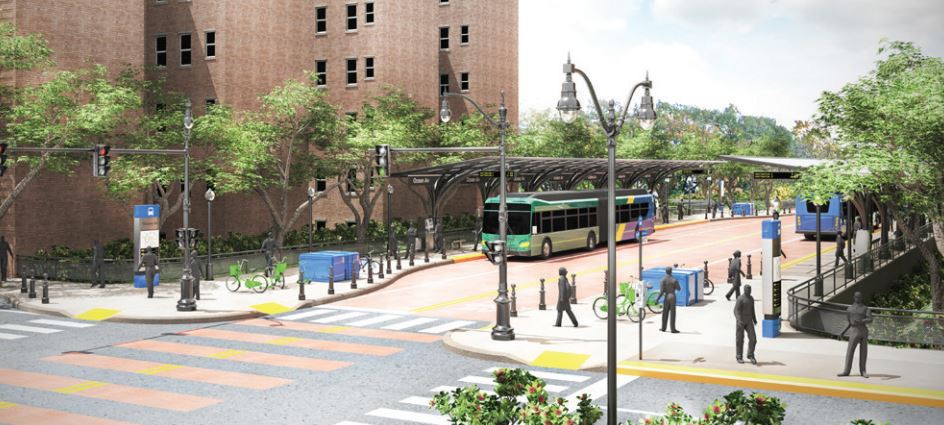
Rendering showing a street-level view of a possible bus rapid transit station in Brooklyn (Rendering provided by the MTA)
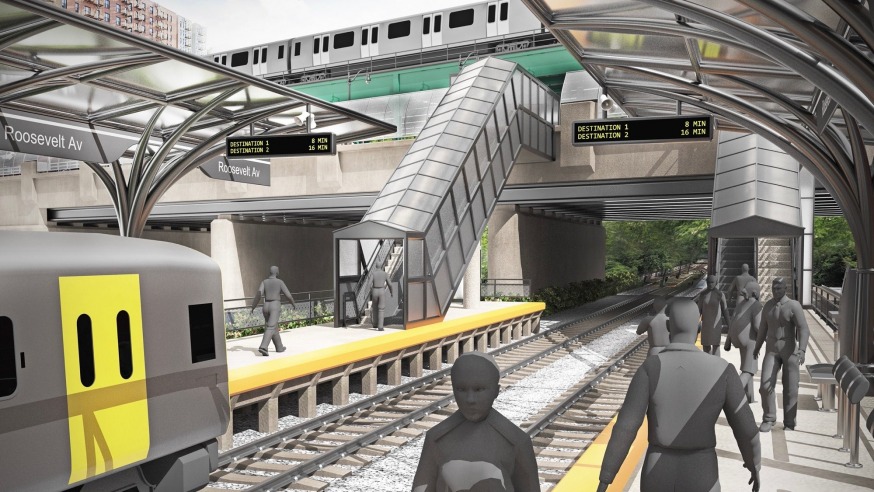
Rendering of platform-level view of the conventional rail alternative at a possible Roosevelt Avenue Station (Rendering provided by the MTA)
2 Comments

Jenny: You are correct. Hochul and other project supporters forgot to tell you about the existing G line service that has been running from Brooklyn to Queens for decades. It was built as part of the municipal Independent Subway (IND) system constructed in the 1930’s! Whomever provided her with the proposed system map, air brushed this out. Reminds me of the late Soviet Union dictator Joseph Stalin. He would have people who fell out of favor removed from all previous photos.
Completion of Communication Based Train Control on both the Queens Blvd. E/F & R line along with F line Brooklyn routes will provide increased capacity. Current G line service terminating at Court Square could be extended to Forest Hills, Continental Avenue. This would restore this connection which was terminated several decades ago.
In Brooklyn, G line service could be extended beyond Church Avenue to Coney Island Stillwell Avenue Terminal. This would provide connections to the D, N & Q lines.
The G line Fulton Street train station is located several blocks from the Atlantic Avenue/Barclay Center LIRR/NYC Transit subway station complex. A simple underground passageway could be constructed. This could provide a direct indoor connection to the G line from the 2,3,4 & 5 IRT, B.D.N,Q & R BMT subway lines along with the Atlantic branch LIRR.
(Larry Penner — transportation advocate, historian and writer who previously worked for the Federal Transit Administration Region 2 New York Office. This included the development, review, approval and oversight for billions in capital projects and programs for NY MTA, NYC Transit, Long Island Rail Road, Metro North Rail Road MTA Bus, NYC DOT Staten Island Ferry along with 30 other transit agencies in NY & NJ)..
Project costs will probably include a series of new stations with elevators and escalators. This is necessary to provide transfer capacity with subway and LIRR stations that intersect along the proposed route. (Each connecting station could easily cost from $50 to $100 million; (Imagine the costs of escalators and including elevators to be in compliance with ADA). Add to that — new track, signals, power, power substations and hundreds of new subway cars ($3 million per car). This additional fleet would require construction of a new maintenance, operations and storage yard (several hundred million.) What community would be willing to host such a facility? There is also a serious conflict at Bay Ridge, Brooklyn. This is also a potential site for a connection to the proposed $10 billion Cross Harbor Freight Tunnel project.
History has told us that construction of major new transportation system expansion projects have taken decades. There is the completion of feasibility studies followed by environmental reviews, planning, design, engineering, real estate acquisition, permits, Federal Rail Road Administration approval, budgeting, identifying and securing funding to pay for all of the above before construction can start. The final cost could be several billion more than the 2016 Regional Planning Association $1 to $2 billion.
(Larry Penner is a transportation advocate, historian and writer who previously worked for the Federal Transit Administration Region 2 New York Office. This included the development, review, approval and oversight for billions in capital projects and programs for the MTA along with 30 other transit agencies in NY & NJ).